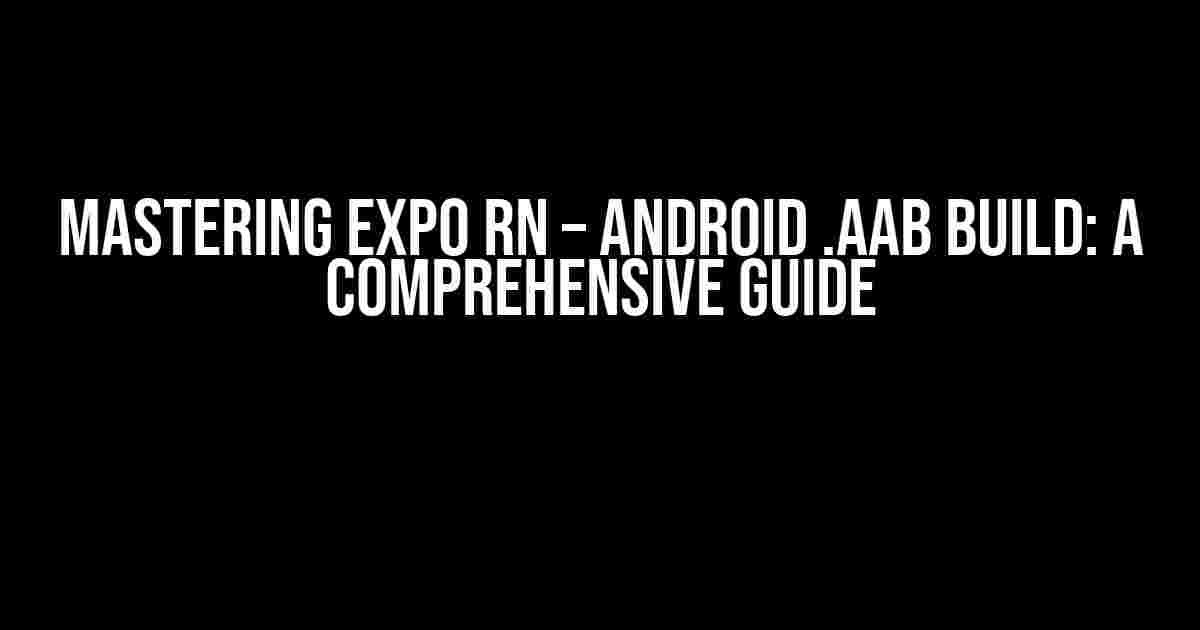Welcome to this in-depth guide on creating an Android .aab build for your Expo RN (React Native) project. By the end of this article, you’ll be well-versed in the process, and your app will be ready for release on the Google Play Store.
What is an .aab file?
An .aab file is a container file that packages your Android app’s code, assets, and metadata. It’s the new standard for Android app distribution, replacing the traditional .apk file. The .aab format offers several advantages, including:
- Faster and more efficient app installation
- Better compression and smaller file size
- Improved security and tamper-evidence
- Built-in support for dynamic feature modules
Prerequisites
Before we dive into the process, make sure you have:
- Expo CLI installed on your system (run
npm install expo-cliif you haven’t already) - An Expo RN project set up (run
expo initto create a new project) - Akeady configured and registered your app on the Google Play Console
- A code signing certificate and keystore file
Step 1: Prepare Your Project
Before building your .aab file, ensure your project is configured correctly:
- In your project’s
app.jsonfile, update theandroidsection to include the following:
"android": {
"package": "com.yourcompany.yourapp",
"versionCode": 1,
"versionName": "1.0.0"
}
- In your
android/gradle.propertiesfile, add the following:
android.useAndroidX=true android.enableJetifier=true
Step 2: Configure Code Signing
To secure your app, you’ll need to configure code signing:
- Create a new file called
keystore.propertiesin your project’s root directory:
storeFile=keystore.jks storePassword=your_store_password keyAlias=your_key_alias keyPassword=your_key_password
- In your
android/app/build.gradlefile, add the following:
android {
...
defaultConfig {
...
signingConfig {
storeFile file('keystore.jks')
storePassword 'your_store_password'
keyAlias 'your_key_alias'
keyPassword 'your_key_password'
}
}
}
Step 3: Build Your .aab File
Now, it’s time to build your .aab file:
- Run the following command in your terminal:
expo build:android -t app-bundle
This command will generate an .aab file in the android/app/src/main/assets directory.
Step 4: Optimize and Align Your .aab File
To ensure your .aab file is optimized and aligned for the Google Play Store, run the following command:
zipalign -v 4 android/app/src/main/assets/app.aab aligned-app.aab
This command will create an optimized and aligned version of your .aab file, which is required for Google Play Store uploads.
Step 5: Upload Your .aab File to the Google Play Console
Final step: upload your .aab file to the Google Play Console:
- Go to the Google Play Console and navigate to your app’s listing
- Click on the “Release management” tab and select “App releases”
- Click on the “Create release” button and select “Android App Bundle (.aab file)”
- Upload your aligned .aab file and fill in the required information
- Review and confirm your release
Troubleshooting and FAQs
Having issues or questions? Check out these common issues and their solutions:
| Issue | Solution |
| Error: “Failed to read keystore file” | Ensure your keystore file is in the correct location and the passwords are correct. |
| Error: “Unable to find keystore alias” | Double-check your keystore alias and password in the keystore.properties file. |
| Error: “aab file is not optimized for the Google Play Store” | Run the zipalign command to optimize and align your .aab file. |
Conclusion
With these steps, you’ve successfully created an Android .aab build for your Expo RN project. Remember to keep your keystore file and passwords secure, and don’t hesitate to reach out if you encounter any issues.
Get ready to publish your app on the Google Play Store and share it with the world!
Additional Resources
- Expo Documentation: Building Android App Bundle (AAB)
- Google Play Console: Upload an Android App Bundle
- Android Developers: Android App Bundle
Happy building!
Frequently Asked Question
Get answers to your most burning questions about Expo RN – Android .aab build!
What is an .aab file, and why do I need it for Expo RN?
An .aab file, also known as an Android App Bundle, is a file format used to distribute Android apps. You need it for Expo RN because it’s the recommended way to publish your app to the Google Play Store, as it allows for more efficient app size and better analytics.
How do I generate an .aab file for my Expo RN project?
To generate an .aab file, you can use the Expo CLI command `expo build:android -t app-bundle`. This command will create an .aab file that you can upload to the Google Play Store.
What are the benefits of using an .aab file over a traditional APK?
Using an .aab file provides several benefits, including smaller app size, better performance, and improved security. Additionally, .aab files allow for more flexible app updates, as users can download only the necessary changes instead of the entire app.
Can I use an .aab file for other Android app stores besides the Google Play Store?
Yes, you can use an .aab file for other Android app stores, such as the Amazon Appstore or Huawei AppGallery. However, some stores may require a traditional APK file instead, so be sure to check the specific store’s requirements.
How do I troubleshoot issues with my .aab file or Expo RN Android build?
If you encounter issues with your .aab file or Expo RN Android build, you can check the Expo documentation, or seek help from the Expo community or a professional developer. Additionally, you can try running `expo diagnostics` to identify potential issues with your project configuration.
